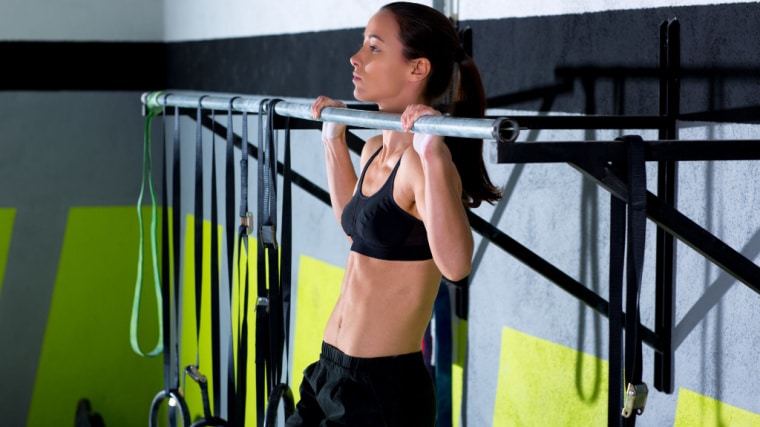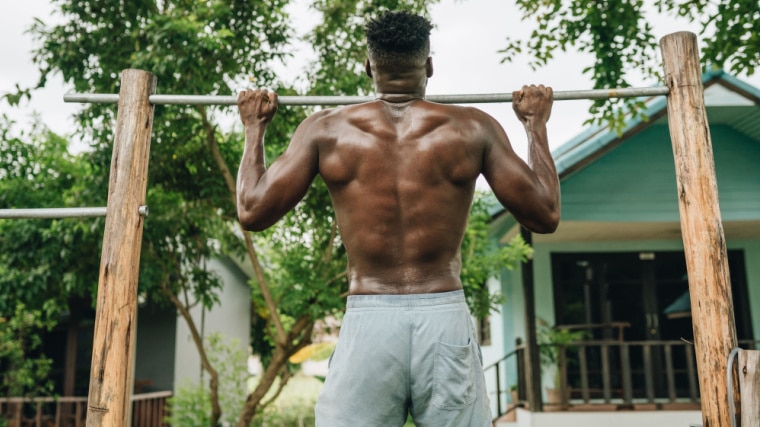Few exercises can be as daunting as the pull-up. Having the strength necessary to perform one single repetition is a challenge for many. Yet, it is a milestone everyone should strive for. It’s frustrating to struggle performing pull-ups, but it’s even worse to leave them out of your program entirely. This staple exercise should be … Read more
The post Everything You Need to Know About Pull-Ups for Beginners appeared first on Breaking Muscle.
Few exercises can be as daunting as the pull-up. Having the strength necessary to perform one single repetition is a challenge for many. Yet, it is a milestone everyone should strive for. It’s frustrating to struggle performing pull-ups, but it’s even worse to leave them out of your program entirely.

This staple exercise should be the backbone of many pulling workouts for beginners and advanced lifters alike. You don’t even need a gym. Heck, you don’t really even a pull-up bar. A sturdy tree or swingset can be enough to deliver you massive back, shoulder, and arm gains. Mastering the pull-up will be a game changer in your fitness journey.
- Benefits of the Pull-Up
- How to Do the Pull-Up
- Pull-Up Variations
- Pull-Up Form Tips
- How to Program the Pull-Up
Benefits of the Pull-Up
The pull-up is a training staple for a reason. It delivers a myriad of benefits from mastering your own body to getting stronger to adding lean muscle. Let’s cover them all.
Functional Strength
Yes, functional training has been a trend in recent years. To specifically define what makes an exercise “functional” is a bit of headache, but there is a certain beauty and practicality in being able to move your own body around, just like with the push-up, running, or jumping. Mastering bodyweight movements and building coordination is a quality every human should strive for.

What is clear is that the pull-up can improve your overall strength and is transferable to many other activities and exercises, such as climbing, gymnastics, or even wrestling. Being stronger at the pull-up is being stronger at life, with improved grip strength and stronger back, arm, and core muscles.
Building Muscle
The pull-up shows up in so many resistance training plans because of its efficient ability to build size. It is one of the best, if not the best, muscle-builders for the back.(1) It is also a tremendous exercise for upper arm and forearm size. Moreover, it spares your lower back and legs from participating in the movement, which can be great if you’re injured or want to avoid excessive training volume in these body parts.
You can focus more on your pulling muscles, which improves your mind-muscle connection and provides quality volume to the target muscles. This will give you the best chance of building a well-developed back.(2)(3)
Better Grip
Grip strength can be easily overlooked, but is actually invaluable. Most exercises, even for the lower body, use your hands. The pull-up can improve your grip because you are required to lift your entire body and connect yourself to the bar.
This will directly be transferable to other pulling exercises and deadlift variations, but strong forearms and grip will also stabilize your wrists during pressing exercises such as the bench press, and can improve overall wrist, elbow, and shoulder joint health.(4) Grip strength is also linked to longevity and general health, which is a hefty bonus.(5)
How to Do the Pull-Up
The pull-up might be a bodyweight exercise, there is still technique involved if you want to master it and reap all its benefits.

- Set yourself in position by hanging from a bar with your arms completely extended using a slightly wider than shoulder-width grip and your hands pronated (palms facing away from you).
- Pull your shoulder blades back, raise your chest, and engage your core to prevent yourself from swaying.
- Pull yourself toward the bar by flexing your elbows and squeezing your back until your chin is over the bar. If you’re a taller lifter or have long limbs, you might need to stop sooner if your back and arms fully contract before that point.
- Exhale and hold the contraction for one second while keeping your chest arched and your body tensed.
- Lower slowly by extending your arms in a controlled fashion to prevent as much swaying as possible.
- Once you’re at a dead-hang, you’ve completed a pull-up. Repeat for the desired amount of repetitions.
Pull-Up Variations
The task ahead is daunting, but the challenge of the pull-up is worthy and you shouldn’t be intimidated by it. If you struggle with the movement, there are some variations that will help you towards your first good rep.
Negative Pull-Up
With this variation, you’re only doing the eccentric (lowering) part of the lift. To perform it, simply stand on a box, grab the bar and jump into the top position. Then slowly lower yourself in four to five seconds.
This is an excellent variation if you struggle with pull-ups, want to build pull-up strength, or cannot perform one strict repetition. You’ll be able to do these because muscles are stronger during the eccentric part of a lift.(6) This way, you can accumulate pull-up volume and practice the lift as well as gain strength in the desired muscles, even if you can’t perform a full range of motion pull-up.
Band-Assisted Pull-Up
A resistance band will “lighten” your body weight so the exercise requires less strength. This is a better variation to get better at pull-ups than the machine assisted pull-up, because the band incorporates some components of total-body stability and coordination.
Loop a durable resistance band around the bar and let it hang down. Put your feet in it, keeping your legs straight and your body tense. Now start pulling. The feeling and overall technique is very close to the unassisted bodyweight pull-up, so it will have plenty of direct carryover.
Inverted Row
This goes by many different names — horizontal row, bodyweight row, Australian pull-up — but it’s a relatively easier version of the pull-up because now you’re pulling horizontally and you’re moving a lower percentage of your body weight. It’s a perfect variation to master before trying pull-ups, as it recruits and trains the same muscles.
Set yourself under a fixed bar and grab it using a pronated (palms down) grip. Flex your core and legs so that your body is tense and in a straight line. Now, pull your chest to the bar. The inverted row is efficient because you can easily scale it down or up.
If it’s too tough, set the bar higher which improves your leverage and decreases the body weight being pulled. If it’s not challenging enough, reduce the bar height, and eventually elevate your feet to make the lift even harder. When you feel confident enough, the pull-up will be awaiting you.
Pull-Up Form Tips
If you want to really nail down your pull-up game, pay attention to these form tips. Proper technique is essential to prevent injuries and progress faster.
Brace Your Whole Body
You might think of the pull-up as only a back and arms movement, but that’s not the case if you want maximum efficiency. Studies have shown that the abs, for instance, are heavily involved in the pull-up.(7) Why is that? Your core — composed of your abs, lower back, and some hip muscles — as well as your legs have to work extra hard to stabilize your body.

During the pull-up, take a deep breath in and flex your abs as much as you can to prevent excessive swinging, which would otherwise alter the efficiency and mechanics of the lift. To recruit your core even more, straighten your legs and hold them together. If you still have trouble preventing swaying, take a few seconds between each rep to reset yourself and ensure picture perfect form.
Keep Your Chest Up
When the lift becomes difficult, it’s tempting to round your upper back and use the assistance of more muscles. The problem is that it internally rotates your shoulders (making them roll forward) and places the shoulder joint in a precarious position.
You have to keep your chest up and your back slightly arched if you want to avoid injuries and train the target muscles correctly. Keep in mind that it will always be better to do fewer repetitions with better form. Doing your pull correctly will ensure you use your lats as efficiently as possible.
Use a Full Range of Motion
If you’re doing half-reps, you’re not “really” doing pull-ups. Yes, pull-ups are a challenging exercise, but cutting the range of motion short is not a valid strategy to get better at them. By reducing the length of pull, you never work the hardest part of the movement and you reduce time under tension, resulting in poorer muscle gains and strength development.(8)
Sure, you really want to nail this exercise, but you’ll be better off practicing the alternatives with proper form, like negative pull-ups or band-assisted pull-ups, rather than performing half-repetitions and getting half results. Practice perfect technique, use the variations, and you’ll master the pull-up soon enough.
Programming the Pull-Up
The pull-up is a versatile exercise that can be suited to beginners and experienced lifters alike, for a variety of goals. All along your lifting journey, the pull-up is a valuable exercise no matter what your goal is. If you’re stronger, you can even add weight to your pull-ups to keep reaping the strength and size benefits of the exercise.
- For Strength: Perform three to five sets of three to five reps.
- For Muscle Growth: Do three to four sets of eight to 12 reps.
- For Muscular Endurance and Conditioning: Perform two to three sets of 15 to 20 reps.
- For Strength-Skill (Technique): Do eight to 12 sets of one to three reps using short rest periods and avoiding muscular failure.

Pull-ups, like many bodyweight exercises, are a skill dictated by your muscles as well as your nervous system. Remember that perfect technique should always be respected if you want to progress efficiently. Avoid reaching muscular failure while learning the lift. This will prevent excessive fatigue from negatively affecting your technique.
Don’t Pull the Plug on Pull-Ups
The pull-up is too valuable of an exercise to skip just because it’s challenging to learn. Set aside your anxiety, follow the advice laid out above, and start working towards your first pull-up. By the time you’re able to bang a few good reps, your fitness and physique will have drastically improved.
References
- Hewit, Jennifer. (2018). A Comparison of Muscle Activation during the Pull-up and Three Alternative Pulling Exercises. Journal of Physical Fitness, Medicine & Treatment in Sports. 5. 10.19080/JPFMTS.2018.05.555669.
- Calatayud J, Vinstrup J, Jakobsen MD, Sundstrup E, Brandt M, Jay K, Colado JC, Andersen LL. Importance of mind-muscle connection during progressive resistance training. Eur J Appl Physiol. 2016 Mar;116(3):527-33. doi: 10.1007/s00421-015-3305-7. Epub 2015 Dec 23. PMID: 26700744.
- Schoenfeld BJ, Contreras B, Krieger J, Grgic J, Delcastillo K, Belliard R, Alto A. Resistance Training Volume Enhances Muscle Hypertrophy but Not Strength in Trained Men. Med Sci Sports Exerc. 2019 Jan;51(1):94-103. doi: 10.1249/MSS.0000000000001764. PMID: 30153194; PMCID: PMC6303131.
- Coombes BK, Bisset L, Vicenzino B. Management of Lateral Elbow Tendinopathy: One Size Does Not Fit All. J Orthop Sports Phys Ther. 2015 Nov;45(11):938-49. doi: 10.2519/jospt.2015.5841. Epub 2015 Sep 17. PMID: 26381484.
- Bohannon RW. Grip Strength: An Indispensable Biomarker For Older Adults. Clin Interv Aging. 2019;14:1681-1691 https://doi.org/10.2147/CIA.S194543
- Hody S, Croisier JL, Bury T, Rogister B, Leprince P. Eccentric Muscle Contractions: Risks and Benefits. Front Physiol. 2019 May 3;10:536. doi: 10.3389/fphys.2019.00536. PMID: 31130877; PMCID: PMC6510035.
- Hewit, Jennifer. (2018). A Comparison of Muscle Activation during the Pull-up and Three Alternative Pulling Exercises. Journal of Physical Fitness, Medicine & Treatment in Sports. 5. 10.19080/JPFMTS.2018.05.555669.
- Burd NA, Andrews RJ, West DW, Little JP, Cochran AJ, Hector AJ, Cashaback JG, Gibala MJ, Potvin JR, Baker SK, Phillips SM. Muscle time under tension during resistance exercise stimulates differential muscle protein sub-fractional synthetic responses in men. J Physiol. 2012 Jan 15;590(2):351-62. doi: 10.1113/jphysiol.2011.221200. Epub 2011 Nov 21. PMID: 22106173; PMCID: PMC3285070.
Featured Image: MilanMarkovic78 / Shutterstock
The post Everything You Need to Know About Pull-Ups for Beginners appeared first on Breaking Muscle.







